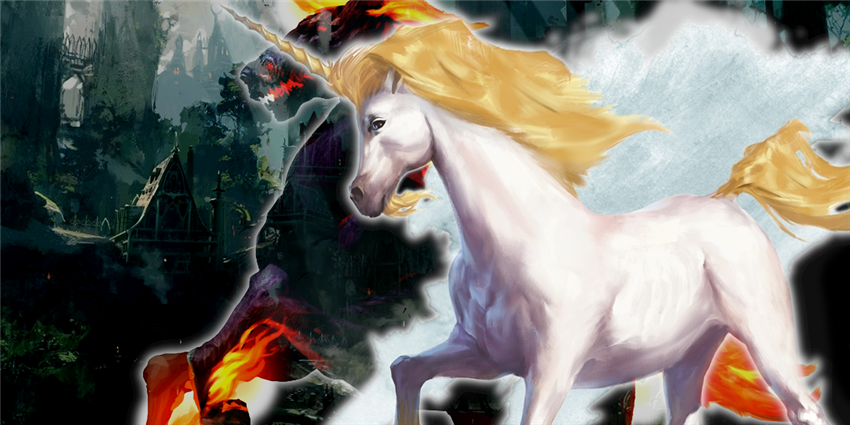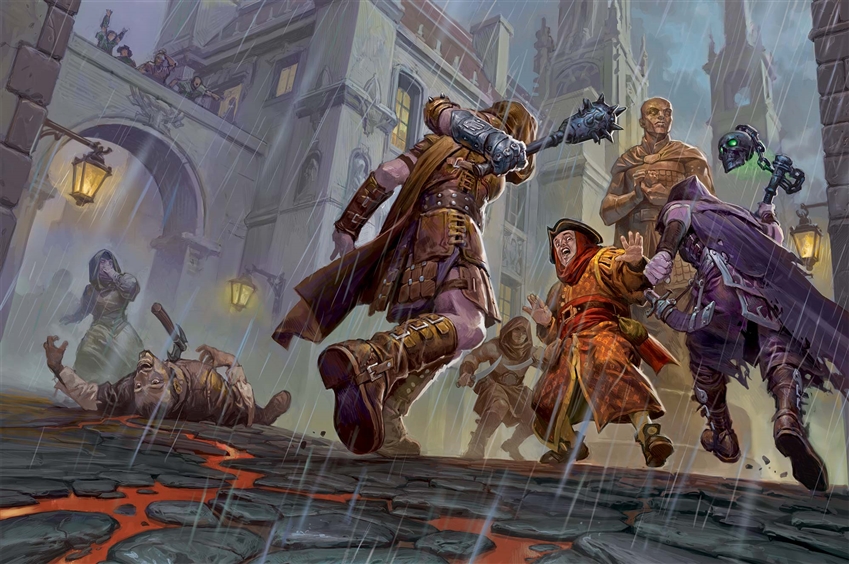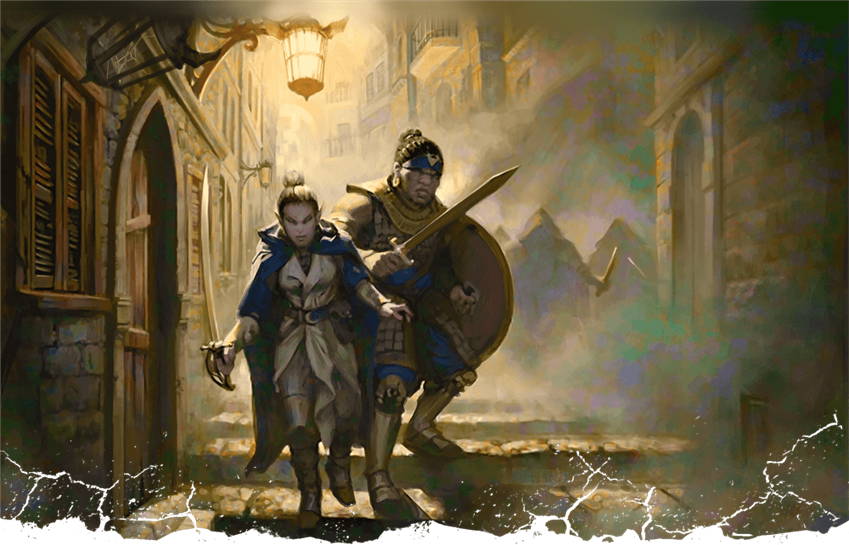Take a second to think about some of the most memorable chase scenes in cinema.
Hardboiled cop Popeye Doyle in The French Connection, weaving in and out of traffic in a madcap race to catch a train. James Bond, climbing a construction site in Casino Royale as his prey makes death-defying leaps across scaffolding. Indy and his friends in Indiana Jones and the Temple of Doom, piloting a mine cart as they flee from Thuggee pursuers.
Chase scenes remain in a viewer’s head forever. And with some planning, any Dungeon Master can create the same nail-biting moments in a game of Dungeons & Dragons, delivering just as many thrills as a combat encounter when done well.

The Rules of the Chase
Chase rules are located in Chapter 8 of the Dungeon Master’s Guide. Here are the most important points:
- Chases require a quarry and at least one pursuer, and in some instances, the pursuer can become the quarry. (For instance, if you’re running after a thief in a market and guards suddenly arrive, assume you’re the thief, and run after YOU instead.)
- The quarry should start the chase some distance ahead of the pursuer.
- Once that distance is determined, have all parties roll for initiative, but keep in mind that players are only allowed one action and one move. Bonus actions and reactions are not permitted, likely to streamline the chase and keep classes with high movement capabilities from catching the quarry too soon.
- Chase participants can freely use the Dash action 3 times plus their Constitution modifier. For every usage of Dash afterward, they must pass a DC 10 Constitution check or gain a level of exhaustion. Once they hit exhaustion level 5 and their speed drops to 0, they fall out of the chase.
- Every chase participant rolls a d20 at the end of their turn to see if complications occur. Complications are the bread and butter of D&D chases, and the Dungeon Master’s Guide presents two tables to consult from - Urban Chase Complications and Wilderness Chase Complications. More on those later, but one vital tidbit to remember: Complications affect the NEXT creature in the initiative order, not the one who just made their roll!
- Chases can end in a few ways: 1) When the quarry or pursuer drop from exhaustion, 2) When the pursuer catches up to the quarry, perhaps initiating normal combat rules, 3) When the quarry succeeds on a Dexterity (Stealth) check at the end of a round to hide (assuming they’ve escaped the pursuer’s sight), and my favorite, 4) When you, the DM, decide to call it!
Keeping these rules in mind, one thing is clear - a chase should be treated as a deliberate activity - a D&D mini-game - and there needs to be a clear delineation on the DM’s part to state: “Okay, now we’re in a chase scene. Your main goal is not to incapacitate this opponent, but to catch them.”

The Design of the Chase
Because chase rules are quite separate from normal D&D gameplay, I’ve found it best to only use them for critical story moments when you, as a DM, absolutely know that a chase is going to occur. Sure, you could also utilize them during a random battle when your players want to nab that fleeing bugbear, but I prefer my chases to be bold set pieces - for instance, a dash across the castle’s parapets in order to catch the assassin who’s poisoned the king!
Once the story impetus has been decided, consider whether you’ll run the chase as a Theater of the Mind exercise or on a tactical grid. Theater of the Mind may be easier since chases cover large distances and battle maps tend to make players think in terms of D&D’s normal movement rules, which are intended for small skirmishes where one square generally equals five feet. Or, if you’re playing virtually, using D&D Beyond’s shared dice rolling feature can keep everyone involved in watching the tension unfold.
Next, determine if your chase is an on-foot affair or if other forms of transportation will be involved. The rules assume that chase participants will be running, but you could put everyone on warhorses or even elephants simply by looking up the stat blocks on D&D Beyond. You could even use the stats of these mounts to represent vehicles that don’t have readily available stat blocks, which is a handy DM hack I’ve often used in the past.
Finally, when you’re running the chase itself, judiciously throw unpredictable hurdles at both the pursuers and the quarry at the end of each turn. The Chase Complications tables in the Dungeon Master’s Guide offer up great examples, like a stained glass window players have to jump through in an urban chase, or a swarm of insects that might collide with the party during a wilderness chase. I’d recommend tweaking these tables as appropriate for your campaign, since they barely scratch the surface of possibilities in more varied settings - for instance, snowy mountaintops. (Imagine a squad of feverish Chardlyn Berserkers chasing the heroes across an icy bridge in Icewind Dale: Rime of the Frostmaiden!)
Be aware that both tables in the Dungeon Master’s Guide state that d20 rolls of 11-20 lead to no complication. If you’d rather have no lulls in the action, try creating your own complications for these rolls. For example, in my Ghosts of Saltmarsh game, I had rolls from 11-15 result in chase participants crashing into important NPCs. One of my players rolled a 13, barrelled through the window of a Saltmarsh public bathroom, and came face to face with Oceanus, the sea elf she’d rescued ages ago from pirates. A hilarious moment was had by all - and then Oceanus joined the pursuit!
Lastly, chases are an incredible opportunity to flex your DM narration skills. A pursuer doesn’t just jump through that stained glass window - they catapult themselves into it like Batman, dozens of shards ripping their cloak as they somersault forward, barely getting up in time to catch a glimpse of their quarry’s feet darting down an alleyway to their right. That insect swarm doesn’t just make an attack of opportunity on the prey running past it - they lash out with their stingers in a dissonant symphony of frenzied buzzing. Amp up the colorful language, aim to recreate a film feel, and watch as the chase ends up leaving a deep impression on your players, just like the opening of Casino Royale.

The Thrill of the Chase
For a good chase template, look no further than Chapter 4 of Waterdeep: Dragon Heist, which features both street and rooftop chases. Personally, I’ll never forget the moment in this campaign when my rogue parkoured across Waterdeep’s chimneys trying to catch three-spined devils. The player before me rolled a 7 on the scene’s Rooftop Chase Complications table, and my DM said that the flagpole of Waterdeep’s Kara-Tur embassy was coming my way, threatening to slow me down.
Luckily, I made my DC 15 Dexterity saving throw - rolled a natural 20, in fact - and swung around the flagpole three times, cartwheeling into the air and nimbly joining my comrade as we lashed a flurry of daggers out at our foes.
That moment, I really felt the thrill of the chase - and the movie in my head was just as good as any I’d seen on screen.
Add some wild chases to your crazy mysteries and preorder Candlekeep Mysteries!
Jeremy Blum (@PixelGrotto) is a journalist, gaming blogger, comic book aficionado and fan of all forms of storytelling who rolled his first polyhedral dice while living in Hong Kong in 2017. Since then, he's never looked back, and loves roleplaying games for the chance to tell the tales that have been swirling in his head since childhood.








-
View User Profile
-
Send Message
Posted Feb 17, 2021nice!
-
View User Profile
-
Send Message
Posted Feb 17, 2021Welcome, Jeremy! Nice article! It's nice to see new ones coming out!
-
View User Profile
-
Send Message
Posted Feb 17, 2021Yay, another article!
-
View User Profile
-
Send Message
Posted Feb 17, 2021Hope: restored! 👍
-
View User Profile
-
Send Message
Posted Feb 17, 2021The beacons are lit!
-
View User Profile
-
Send Message
Posted Feb 17, 2021FINALLY!!!!!!!!!! Thank you for making a new article!!!!!!!!!!!!!!!!!!!!!!!!!!!!
-
View User Profile
-
Send Message
Posted Feb 17, 2021Hurrah!
-
View User Profile
-
Send Message
Posted Feb 17, 2021Welcome Jeremy! Great article!
-
View User Profile
-
Send Message
Posted Feb 17, 2021Yay!^^^^^^^^^^^^^^^^^^^^^^
-
View User Profile
-
Send Message
Posted Feb 17, 2021I'm not sure the chase rules actually specifically forbid reactions and bonus actions. It just says, "As in combat, each participant in the chase can take one action and move on its turn." And that is referencing combat, and so is unclear.
-
View User Profile
-
Send Message
Posted Feb 17, 2021It says no opportunity attacks in the chase rules in the DMG, but can you take other reactions and bonus actions? Also, nice start! It's a welcome change after a week of ads and reposts.
-
View User Profile
-
Send Message
Posted Feb 17, 2021Awesome! New article!
-
View User Profile
-
Send Message
Posted Feb 17, 2021Hooray! *throws confetti*
-
View User Profile
-
Send Message
Posted Feb 17, 2021Hurrah! New articles!
-
View User Profile
-
Send Message
Posted Feb 17, 2021For those inquiring about bonus actions and reactions, that's a worthy question! The fact that the DMG doesn't specifically mention them - as well as the fact that chase rules are their own separate thing - were enough for me to decide that in my games, at least, bonus actions and reactions are impossible due to the hectic, frenzied nature of the chase. Another DM might certainly decide to interpret the rules differently, though I'll say that the huge movement options that classes like Rogues and Monks get on bonus actions can very easily catch a quarry within a single round.
-
View User Profile
-
Send Message
Posted Feb 17, 2021Sure, that makes sense. Fast characters with speed-enhancing bonus action and reaction options should be slower.
Sorry, but rules or not, that's idiocy, regardless of whether Crawford chimes in or not.
There's RAI, RAW, and RAF, but there should also be one above all: Rules as Making Some Kind of Sense RAMSKOS.
-
View User Profile
-
Send Message
Posted Feb 17, 2021Great first article Jeremy! I'll be sure to use it sometime soon!
-
View User Profile
-
Send Message
Posted Feb 17, 2021*dances*
-
View User Profile
-
Send Message
Posted Feb 17, 2021I ran the chase encounter in Dragon Heist about 2 weeks ago. It actually went really well. I let people use their bonus actions and what not. It wasn't much of a problem. It let our rogue catch up really quick which allowed them to try to tackle/grapple the quarry.
I kept track of the quarry's dashes as well as the party and I used a street map of Waterdeep. This became important because our Wizard figured he would let his owl familiar follow the quarry then just find out where they stopped.
Interestingly, only one of my players ever decided to use some ranged attacks to try to slow down or injury the quarry. In the end it came down to the ranger the quarry and the owl and they cornered the quarry, injured badly, in an abandoned building. Perfect for the next encounter in the chain.
-
View User Profile
-
Send Message
Posted Feb 17, 2021We started playing DnD within Discord (using DDB) in March (2019) during the pandemic here in Pennslyvania. Using the chase rules during a session was a disaster. Mainly because one of the players could not rationalize distance without a visual reference like miniatures or a VTT. That being said, any suggestion on using these rules within a medium without a vtt when playing online?